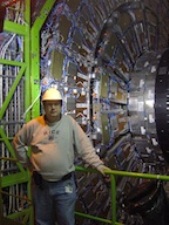Jul 20 2013
A discovery facilitated by Rice University’s contribution to the Large Hadron Collider (LHC) will impact scientists’ search for dark matter in the universe.
 Rice University particle physicist Paul Padley, shown at the Compact Muon Spectrometer, is a co-author of a paper by CERN scientists detailing measurements of B-sub-s meson decay at the Large Hadron Collider. (Credit: Rice University)
Rice University particle physicist Paul Padley, shown at the Compact Muon Spectrometer, is a co-author of a paper by CERN scientists detailing measurements of B-sub-s meson decay at the Large Hadron Collider. (Credit: Rice University)
CERN, the European Organization for Nuclear Research, announced in Switzerland this morning that researchers on two separate LHC experiments have succeeded in measuring “one of the rarest measurable processes in physics,” the decay of B-subscript-s mesons into two muons. The evidence, which scientists have been seeking for 25 years, matches predictions made using the Standard Model of Particle Physics.
That match, with only a 1-in-100,000 chance of being caused by a statistical error, virtually eliminates any possibility that B-sub-s meson decay is related to interaction with particles predicted by dark matter theories, as some physicists have suspected.
Papers with the results have been posted online and have been submitted to the journal Physical Review Letters.
The Compact Muon Solenoid (CMS), an LHC component that played a role in last year’s discovery of the Higgs boson, is one of the two experiments that captured the new data. (The other is the LHCb experiment.) Rice scientists have spent decades designing components for the CMS and are now enjoying the chance to help analyze the results.
“The particle itself was discovered quite some time ago, and that isn’t news,” said Rice physicist Paul Padley, a co-investigator on the CMS experiment and a co-author of the new paper along with nine of his Rice colleagues. “The news is that the Standard Model has predicted that this B-sub-s meson will decay to two muons very, very rarely, and that is what we’ve seen.”
The CMS finds rare needles in very large haystacks of data when protons are smashed together at near-light speed in the world’s largest collider. Electronics invented at Rice help sort useful data about subparticles produced by the collisions from background noise. (Read about Rice’s history with CERN here.)
According to a statement by CERN, for every billion B-sub-smesons produced, only three or so are expected to decay into two muons, heavier cousins of the electron. That expectation is confirmed by the new data. Physicists look for results inconsistent with those predicted by the Standard Model to expand knowledge of the physical world — but that didn’t happen here.
“It’s extremely rare that it should decay this way,” Padley said of the B-sub-s meson. “But there has been the possibility it could decay through new particles predicted by dark matter theories, such as supersymmetry. If it were decaying through supersymmetric or other new particles, then the prediction of how often this decay should happen would be wrong. And we’d get a different answer.
“So the theoretical particle physics community has been extremely interested to see what the two-muon decay rate is for this type of meson,” Padley said. “There are lots of theories that predict that it should be something different from the Standard Model.”
That it precisely matches the model “places constraints on supersymmetric and other models that could explain dark matter in the universe,” he said. “There’s still a whole range of possibilities, but the number of possibilities has shrunk.”
Rice’s contribution encompasses both the equipment used to spot the reactions and the analysis that led to the discovery. Padley gave particular credit to Rice physics instructor Laria Redjimi. “I worked on building the muon trigger, and as a postdoc working for us, she studied it,” he said. “To measure (the data) you have to understand how efficiently the triggering captures these muons. She contributed greatly to that understanding.”
Padley noted that only the LHC is sensitive enough to detect B-sub-s decay, and it will be much more sensitive when updates to the collider — including CMS improvements provided by Rice — are complete in 2015.
Like many physicists, Padley hopes the next round of experiments will provide something unexpected. “There’s no such thing as a wrong result,” he said. “All results tell us things. Unfortunately, the results keep telling us the Standard Model of Particle Physics works phenomenally well, and what we’re seeing now is another stunning success of that model.
“But Mother Nature’s also giving us this picture we know is full of dark matter and dark energy,” he said. “She’s waving dark matter and energy in front of us. We know it’s there; we know it has to exist.”